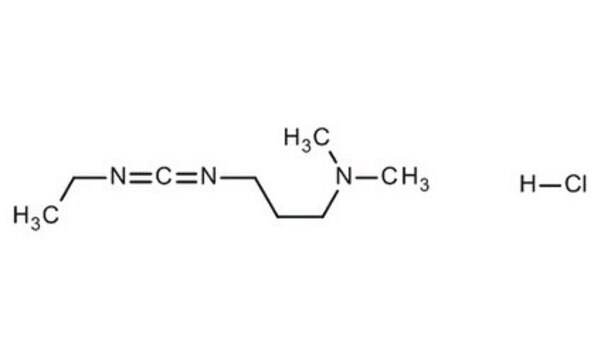EDC and EDAC are both abbreviations for N-(3-Dimethylaminopropyl)-N′-ethylcarbodiimide. While a detailed procedure for conjugating haptens (such as peptides) to carrier proteins such as Bovine Serum Albumin (BSA) is not available, the EDC is typically used at a 5 to 10-fold molar excess with respect to the hapten concentration in the reaction mix. Note that EDC hydrochloride (e.g., Products E6383, E7750 and 03450) is more commonly used as a coupling agent than EDC free base (Product 39391).
39391
N-(3-Dimethylaminopropyl)-N′-ethylcarbodiimide
≥97.0% (T), for peptide synthesis
Synonym(s):
N-Ethyl-N′-(3-dimethylaminopropyl)carbodiimide, EDC, WSC
Select a Size
About This Item
Recommended Products
product name
N-(3-Dimethylaminopropyl)-N′-ethylcarbodiimide, ≥97.0% (T)
Quality Level
Assay
≥97.0% (T)
form
liquid
reaction suitability
reaction type: Coupling Reactions
refractive index
n20/D 1.461
density
0.877 g/mL at 20 °C (lit.)
application(s)
peptide synthesis
functional group
amine
storage temp.
−20°C
SMILES string
CCN=C=NCCCN(C)C
InChI
1S/C8H17N3/c1-4-9-8-10-6-5-7-11(2)3/h4-7H2,1-3H3
InChI key
LMDZBCPBFSXMTL-UHFFFAOYSA-N
General description
Application
Signal Word
Danger
Hazard Statements
Precautionary Statements
Hazard Classifications
Acute Tox. 3 Dermal - Acute Tox. 4 Oral - Aquatic Acute 1 - Aquatic Chronic 1 - Eye Dam. 1 - Skin Corr. 1A - Skin Sens. 1A - STOT RE 2 Oral
Target Organs
Stomach,large intestine,lymph node
Storage Class Code
6.1A - Combustible acute toxic Cat. 1 and 2 / very toxic hazardous materials
WGK
WGK 3
Flash Point(F)
Not applicable
Flash Point(C)
Not applicable
Personal Protective Equipment
Choose from one of the most recent versions:
Already Own This Product?
Find documentation for the products that you have recently purchased in the Document Library.
Customers Also Viewed
Articles
Collagen molecules play a critical role in tissue architecture and strength, and in cell-matrix interactions as insoluble ligands to regulate the diverse phenotypic activities of cells.
-
Which is the suggested EDC concentration and the relative protocol for covalently attach haptens to carrier proteins (e.g. BSA) ?
1 answer-
Helpful?
-
-
How can I determine the shelf life / expiration / retest date of this product?
1 answer-
If this product has an expiration or retest date, it will be shown on the Certificate of Analysis (COA, CofA). If there is no retest or expiration date listed on the product's COA, we do not have suitable stability data to determine a shelf life. For these products, the only date on the COA will be the release date; a retest, expiration, or use-by-date will not be displayed.
For all products, we recommend handling per defined conditions as printed in our product literature and website product descriptions. We recommend that products should be routinely inspected by customers to ensure they perform as expected.
For products without retest or expiration dates, our standard warranty of 1 year from the date of shipment is applicable.
For more information, please refer to the Product Dating Information document: https://www.sigmaaldrich.com/deepweb/assets/sigmaaldrich/marketing/global/documents/449/386/product-dating-information-mk.pdfHelpful?
-
-
How is shipping temperature determined? And how is it related to the product storage temperature?
1 answer-
Products may be shipped at a different temperature than the recommended long-term storage temperature. If the product quality is sensitive to short-term exposure to conditions other than the recommended long-term storage, it will be shipped on wet or dry-ice. If the product quality is NOT affected by short-term exposure to conditions other than the recommended long-term storage, it will be shipped at ambient temperature. As shipping routes are configured for minimum transit times, shipping at ambient temperature helps control shipping costs for our customers. For more information, please refer to the Storage and Transport Conditions document: https://www.sigmaaldrich.com/deepweb/assets/sigmaaldrich/marketing/global/documents/316/622/storage-transport-conditions-mk.pdf
Helpful?
-
-
What is the concentration of the EDC chemical in the 10mL solution?
1 answer-
This product is considered to be a pure/neat EDC material. It has a purity specification of 97% or greater, but it is not a solution of EDC in a solvent.
Helpful?
-
Active Filters
Our team of scientists has experience in all areas of research including Life Science, Material Science, Chemical Synthesis, Chromatography, Analytical and many others.
Contact Technical Service










